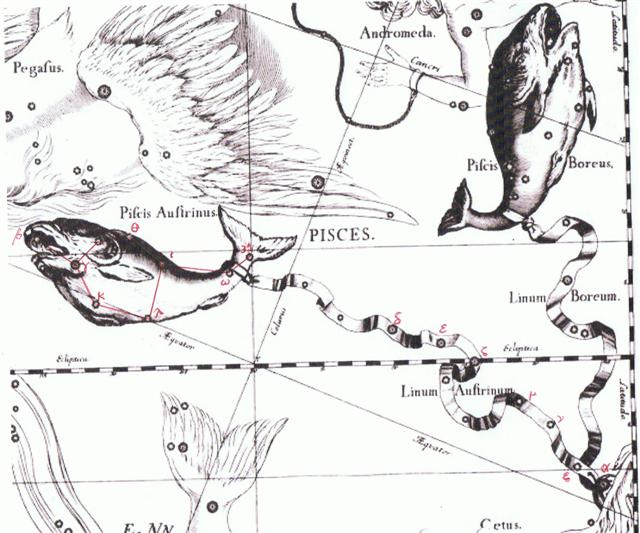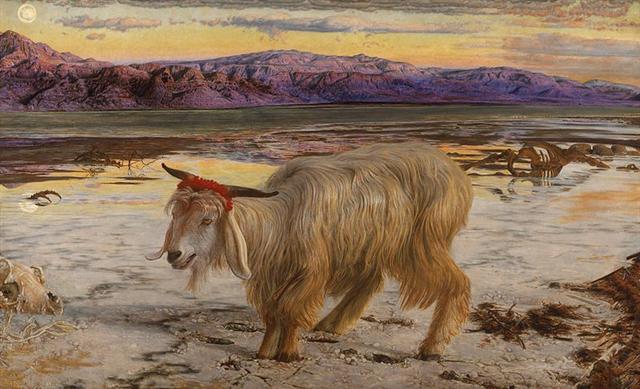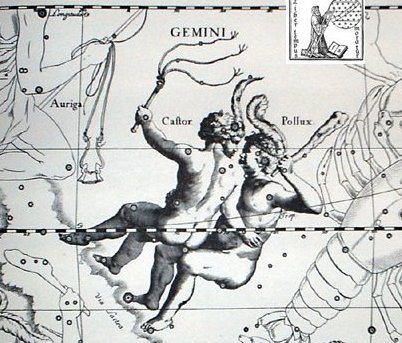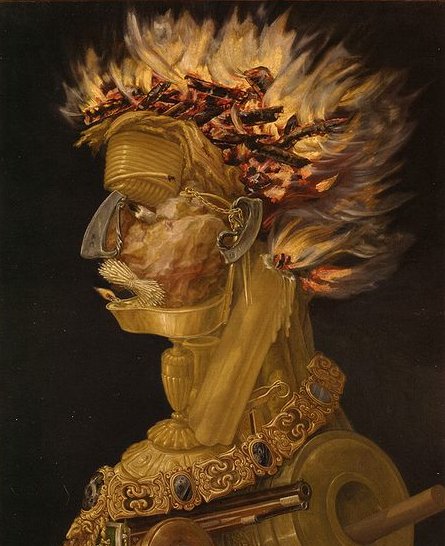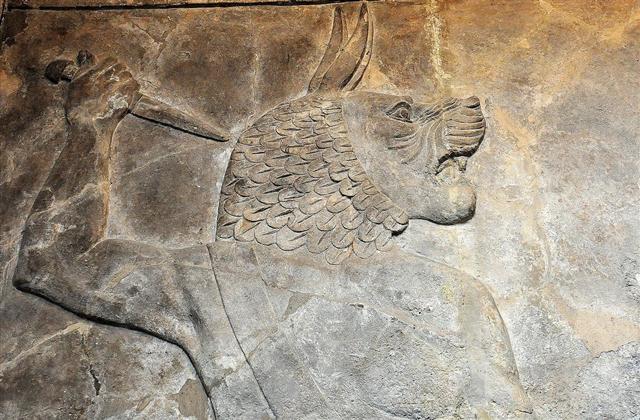Possibly Polaris was alluded to in Gb4-6 - as the star high up in the past and in the background - with some other important star also in the past but instead far down and in the foreground. This was 28 (= 33 - 5) days after Dzaneb at the ring around the tail of the first of the pair of Fishes (Pisces):
... in the ceremonial course of the coming year, the king is symbolically transposed toward the Lono pole of Hawaiian divinity ... It need only be noticed that the renewal of kingship at the climax of the Makahiki coincides with the rebirth of nature. For in the ideal ritual calendar, the kali'i battle follows the autumnal appearance of the Pleiades, by thirty-three days - thus precisely, in the late eighteenth century, 21 December, the winter solstice. The king returns to power with the sun. Whereas, over the next two days, Lono plays the part of the sacrifice ...
The star in the foreground could have been referring to the First Point of Aries. However, Baten Kaitos (the Belly of the Sea Beast, ζ Ceti), rose precisely at the same time as Polaris and should therefore be a better explanation:
Below at left was Phoenix and reclining at the top of the head of the Sea Beast was Aries. Alrisha, the Knot (and last star in Pisces), was securely connected to his neck. His front paws indicated he had reached Land. The Head of Ku could once upon a time have been the Head of this Sea Beast. "Cetus is sometimes represented as swimming in the River Eridanus, although usually as resting on the bank with fore paws in the water; its head, directly under Aries, marked by an irregular pentagon of stars, and its body stretching from the bend in Eridanus to that in the Stream from the Urn." (Allen) Lulal & Latarak (the Lion) below the Hired Man were at this place and according to Mul-Apin they stood for Cetus and a part of Eridanus.
The left foot of Lulal (with a whip like Castor) was evidently on the border line between the 4th quadrant and the new cycle, which resembles the structure described for Gemini:
Pollux could then correspond to Latarak and our Gemini be a repetition of an ancient mind pattern for where the Sea Beast reached Land at Eridanus - Gemini reaching Land after the Milky Way River (and using 3 of their feet for pushing seeds into the mud as anciently had been done with help from sheep):
There is more: "On the Euphrates it [Vindemiatrix] may have been Kakkab Mulu-izi, the Star Man of Fire, possibly symbolizing the god Laterak, the Divine King of the Desert; although that title has been assigned to μ Virginis and δ Librae." (Allen)
It seems rather clear that the Lion (Latarak) in front of Lulal (Castor) was Pollux, with the idea of twins based on the pattern of hot summer ('day') contra wet winter ('night'). Lulal could have represented the winter of the preceding year and Latarak summer in the peceding year. From the point at the end of their 'office' they were together looking back to their glorious past.
Wikipedia: Ugallu, the 'Big Weather-Beast' ... Akkadian: umu rabű, meaning 'big day', was a lion-headed storm-demon and has the feet of a bird who featured on protective amulets and apotropaic yellow clay or tamarisk figurines of the first millennium BC but had its origins in the early second millennium. The iconography changed over time, with the human feet morphing into an eagle’s talons and dressing him in a short skirt. He was one of the class of ud-demons (day-demons), personifying moments of divine intervention in human life ... Ugallu was one of the eleven mythical monsters created by Tiamat in her conflict with the younger gods, on the reverse of the first tablet of the Epic of Creation, Enűma Eliš. The tale describes how Marduk captured and bound the creatures, rehabilitating them with work reconstructing the world from the corpses of his vanquished adversaries. This transformed them into protective charms which would be used to adorn the doors of palaces, for example that of Ashurbanipal’s southwest palace at Nineveh, temples, such as the Esagil of the Marduk temple as described in the Agum-Kakrime Inscription, and private dwellings (the bedrooms of the vulnerable) to ward off evil and disease. Sometimes in pairs of ugallu, the beneficial protective demon finds special purpose in adorning the outer gates of buildings.Ugallu first appears figuratively in the Old Babylonian period as a porter of the underworld, a servant of Nergal. In later times he is represented on amulets as frequently paired with the Sumerian demon Lulal, who was in many respects fairly similar in appearance. He is portrayed clasping a dagger, and described thus: 'a lion’s head and lion’s ears, it holds a … in its right hand and carries a mace (gišTUKUL) in its left, it is girded with a dagger, its name is ugallu' ... |
||||||||||||||||||||||||||||||||||||||||||||||||||||||||||||||||||||||||||||||||||||||||||||||||||||||||||||||||||||||||||||||||||||||||||||||||||||||||||||||||||||||||||||||||||||||||||||||||||||||||||||||||||||||||||||||||||||||||||||||||||||||||||||||||||||||||||||||||||||||||||||||
